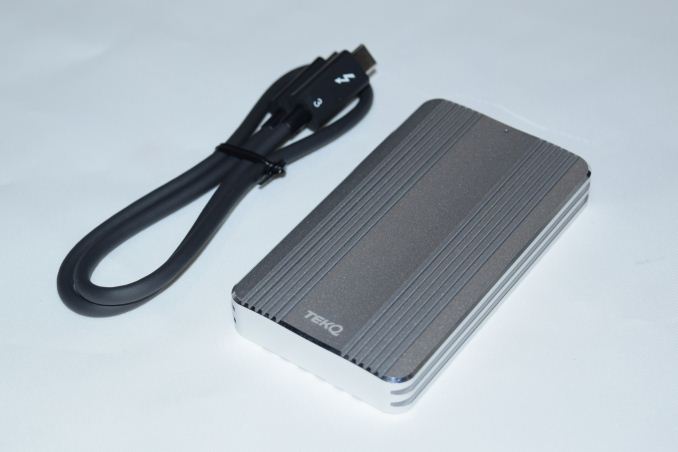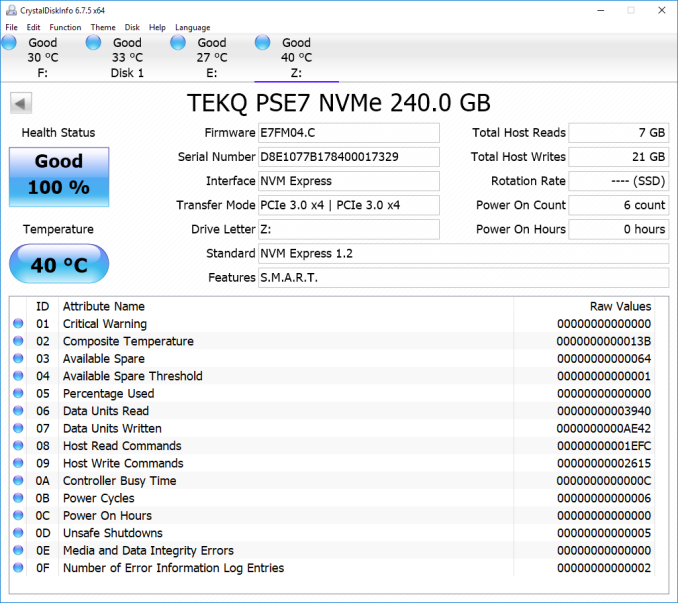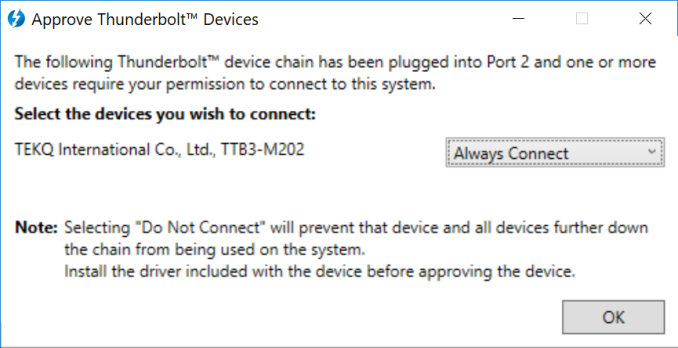TEKQ Rapide Thunderbolt 3 External SSD Review
by Ganesh T S on February 20, 2018 8:00 AM EST- Posted in
- Storage
- SSDs
- DAS
- Thunderbolt 3

Flash-based external direct-attached storage (DAS) devices have evolved rapidly over the last few years. Starting with simple thumb drives that could barely saturate USB 2.0 bandwidth, we now have high-performance external SSDs that take advantage of the USB 3.1 Gen 2 interface to saturate the internal SATA bandwidth. The introduction of PCIe-based SSDs have enabled mass-market storage devices to break the SATA barrier. The proliferation of Thunderbolt 3 (that drives up the available bandwidth by a factor of four compared to USB 3.1 Gen 2) has ensured that the full performance benefits of the internal PCIe interface can be made available in external devices.
A number of high-performance direct-attached storage (DAS) devices have attempted to take advantage of the benefits of Thunderbolt in the last few years. However, they have either required external power adapters (such as the LaCie d2 Thunderbolt 2 SSD Upgrade), or, in the case of bus-powered devices, been held back by an internal SATA SSD (eg.: LaCie Rugged Thunderbolt). The pricing of such devices have also restricted them to the high-end / professional market. In this context, the introduction of a reference platform by Phison at CES 2018 is sure to address the shortcomings of the current external Thunderbolt SSDs in the mainstream market.
Introduction
TEKQ has been in business as a manufacturer of Apple MFI-certified peripherals for some time now. They are new to the direct-attached storage space, but, their first product in that market segment - the Rapide Thunderbolt 3 External SSD - leapfrogs most of the other bus-powered alternatives in the market in terms of both performance and pricing.
The TEKQ Rapide is a 98mm x 45mm x 12mm silver-colored external SSD with an aluminum chassis. It sports a single Thunderbolt 3 interface for both power and data. The port is enabled by the Intel DSL6340 Thunderbolt 3 Controller - note that this belongs to the Alpine Ridge family, and hence, works only with Thunderbolt 3 Type-C ports. On the other side of the DSL6340 is a PCIe 3.0 x4 connection that leads to a M.2 slot capable of accommodating M.2 2260 or 2280 PCIe SSDs. There are no plastic components in the chassis.
There is nothing preventing advanced users from installing their own M.2 PCIe SSDs in the internal M.2 slot. However, TEKQ plans to sell the Rapide in three different capacity points - 240GB, 480GB, and 960GB. Based on our teardown, the internal SSD doesn't seem to be a branded one. Instead, it appears to be a Phison reference design using the E7 controller along with Toshiba's MLC NAND flash.
Unlike similar products such as OWC Envoy Pro EX / EX(VE) that are available for retail purchase right now, TEKQ has opted to go for the crowdfunding route to garner more exposure prior to a wide market release. As a matter of policy, AnandTech does not cover crowdfunding projects. There are very few exceptions - most of the ones that pass our bar are ones where the product is close enough to the launch that manufacturers are ready to have us post a hands-on review of the product. The TEKQ Rapide is one such device. TEKQ's crowdfunding initiative will go live on Feb. 21, 2018.
TEKQ sent over the 240GB variant for review. In addition to the main unit, a 0.5m Thunderbolt 3 cable (certified for 40 Gbps operation) is also bundled.
The TEKQ Rapide is around the size of a credit card, and weighs 135g. With TEKQ's own internal SSD solution, read/write speeds of 2700 MBps / 1500 MBps are claimed, with the random read/write IOPS coming in at 300K/250K respectively.
Prior to looking at the internals, CrystalDiskInfo provides some insights.
Even though CrystalDiskInfo puts only SMART in the features section, we will see later on that TRIM is also supported. The Thunderbolt link is essentially invisible to the tool, with NVM Express listed as the interface. For all practical purposes, the TEKQ Rapide SSD is a PCIe 3.0 x4 NVMe SSD in the system.
Internal Hardware
The TEKQ Rapide is easy to disassemble, with four screws hidden under the rubber feet on the underside of the chassis. The gallery below has pictures of the chassis as well as the internal design and M.2 SSD. The Phison controller and the Toshiba MLC flash are easily seen in the M.2 SSD.
The design includes thermal pads for both the M.2 SSD and the Thunderbolt 3 controller. As we shall see later on, the thermal solution is very effective in keeping the internal temperatures under check even under stressful conditions beyond what a consumer-focused DAS unit might endure.
Usage Impressions
The TEKQ Rapide is plug-and-play except for the small matter of allowing Thunderbolt security to allow one's system to act as a host for the device.
Once approved (needs to be done only once per system if the 'Always Connect' option is chosen), the device mounts as a exFAT volume. This allows for compatibility with both Mac and Windows devices. Since the Thunderbolt 3 / NVMe SSD breezed through our benchmarks in very little time, we were able to evaluate the unit with the volume formatted in exFAT and NTFS.
Unlike some of the other portable SSDs in the market that come with value-adds such as hardware encryption support, the TEKQ is currently keeping it simple. Despite the underlying platform (Phison E7 reference design with Toshiba 15nm MLC flash) supporting AES-256 with TCG / Opal 2.0, the feature doesn't have any user-friendly way to get activated.



















33 Comments
View All Comments
Vatharian - Tuesday, February 20, 2018 - link
I'd actually love to buy enclosure by itself. USB 3.0 to M.2 AHCI adapters are widely available in rather funny prices, while for obvious reasons USB to NVMe are not available at all.This would not only give me very fast attachable storage, but also fool proof way to backup/restore NVMe drives without need to shutdown PC every time.
MajGenRelativity - Tuesday, February 20, 2018 - link
That's my idea tooZeDestructor - Tuesday, February 20, 2018 - link
I'll second that motion, and also put in a request for a U.2 version of the same....I buy entirely too much second-hand server hardware.
Vatharian - Tuesday, February 20, 2018 - link
You're not alone :)As far as I know U.2 (or rather SFF-8639) actually supports hot plug by itself. You can easily drop in external port trough PCI bracket, tie in some power delivery and voila, You'd only need to 3D print or rig some kind of enclosure, or repurpose 2.5" 15mm SATA one.
Still, I am disappointed, that U.2 didn't already die. It should go away, like now. We have much better standards and more robust, too.
Billy Tallis - Tuesday, February 20, 2018 - link
It's a little soon to be asking for U.2 to die. The EDSFF standards are less than a month old and the NGSFF standard is still a few weeks away. U.2 is a transitional standard to bridge the gap between hard drive-based interfaces and form factors, and pure SSD-oriented standards. That transition isn't over yet, and the industry is only just now entering the final phase of that transition.sheepdestroyer - Tuesday, February 20, 2018 - link
But again, there is the power requirement.Will USB be able to provide enough juice to the SSD?
WinterCharm - Tuesday, February 20, 2018 - link
SSD's generally use less power than HDD's.SleepyFE - Tuesday, February 20, 2018 - link
+ USB power delivery can now pump through 100W (5A at 20V).Vatharian - Tuesday, February 20, 2018 - link
I'm not longing for USB NVMe adapter, that's pointless. Thunderbolt has higher power delivery capabilities than USB 3.1 by itself.theopensauce - Wednesday, February 21, 2018 - link
The best and logical comment I've seen on this site so far. I had the same thought with the NVMe backup/restore. There are no good ways to clone NVMe drives presently unless you use an older SSD via USB 3.0. And I am not patient. Plus if you do IT support or run a business time is money and the more efficiency you have the more profit you have.